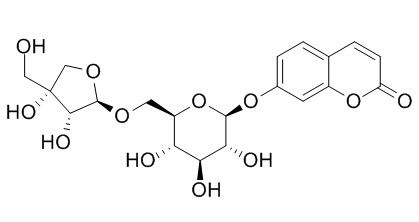Apiosylskimmin
Apiosylskimmin is a natural product from Angelica gigas.
Inquire / Order:
manager@chemfaces.com
Technical Inquiries:
service@chemfaces.com
Tel:
+86-27-84237783
Fax:
+86-27-84254680
Address:
1 Building, No. 83, CheCheng Rd., Wuhan Economic and Technological Development Zone, Wuhan, Hubei 430056, PRC
Providing storage is as stated on the product vial and the vial is kept tightly sealed, the product can be stored for up to
24 months(2-8C).
Wherever possible, you should prepare and use solutions on the same day. However, if you need to make up stock solutions in advance, we recommend that you store the solution as aliquots in tightly sealed vials at -20C. Generally, these will be useable for up to two weeks. Before use, and prior to opening the vial we recommend that you allow your product to equilibrate to room temperature for at least 1 hour.
Need more advice on solubility, usage and handling? Please email to: service@chemfaces.com
The packaging of the product may have turned upside down during transportation, resulting in the natural compounds adhering to the neck or cap of the vial. take the vial out of its packaging and gently shake to let the compounds fall to the bottom of the vial. for liquid products, centrifuge at 200-500 RPM to gather the liquid at the bottom of the vial. try to avoid loss or contamination during handling.
Oncol Rep.2016, 35(3):1356-64
Biol Pharm Bull.2018, 41(11):1645-1651
Hum Exp Toxicol.2022, 41:9603271221143713.
J Cell Mol Med.2020, 24(21):12308-12317.
Aquaculture2019, 510:392-399
Molecules.2023, 28(8):3474.
JPC-Journal of Planar Chromatography 2017, 30(2)
J Inflamm Res.2022, 15:5347-5359.
J Sep Sci.2022, 45(18):3556-3566.
J Ethnopharmacol.2022, 291:115159.
Related and Featured Products
Immunopharmacol Immunotoxicol. 2011 Dec;33(4):663-6.
Antiplasmodial and cytotoxic activity of coumarin derivatives from dried roots of Angelica gigas Nakai in vitro.[Pubmed:
21428713]
The butanol-soluble fraction of the dried root of Angelica gigas exhibited significant protection against chloroquine-sensitive strains of Plasmodium falciparum using the parasite lactate dehydrogenase assay method.
METHODS AND RESULTS:
Using antiplasmodial activity-guided fractionation, five coumarins, marmesinin (1), nodakenin (2), skimmin (3), Apiosylskimmin (4), and magnolioside (5), were isolated and evaluated for in vitro antiplasmodial activity, as well as for their cytotoxic potential on SK-OV-3 cancer cell lines. Compounds 1 and 5 showed notable growth inhibitory activity against chloroquine-sensitive strains of P. falciparum with IC(50) values of 5.3 and 8.2 μM. The compounds showed no significant cytotoxicity (IC(50) > 100 μM) toward the SK-OV-3 cancer cell line.
CONCLUSIONS:
This is the first report on the antiplasmodial activity of these coumarin derivatives from the dried root of A. gigas.



